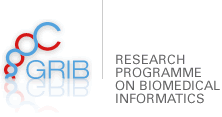Thursday, 31th March, 2011, 11:00-12:00
QM and MM Methods: Obtaining an Atomic and Electronic View of Nature
Speaker: VíCTOR GUALLAR - ICREA - Barcelona Supercomputing Center
Room 473.10 PRBB
Wednesday, 30th March, 2011, 11:00
HeT_A_pi1, a piRNA target sequence in the Drosophila telomeric retrotransposon HeT-A, is extremely conserved across copies and species
Speaker: Natalia Petit- Evolutionary Biology, UPF
Room 473.10_Aula
- Related links
- http://genome.prbb.cat/wordpress/
Thursday, 24th March, 2011, 11:00-12:00
Computational methods to solve the crystallographic phase problem
Chemistry degree in 1987, University of Zaragoza, Dr. Rer. Nat. University of Zaragoza in 1992, Product Research Scientist at the European Research Center in Brussels with Procter & Gamble for 15 months. Moved for a HCM postdoc at the University of Göttingen (Germany) and stayed for an Habilitation (German Higher Doctorate) at (1996-2001) with Prof. Sheldrick, and as C2 leading an independent research group. Moved to Barcelona in September 2003 joining the IBMB-CSIC as ICREA Research Professor.
Speaker: Isabel Usón - Molecular Biology Institute of Barcelona (IBMB)
Room Seminar Xipre (PRBB) - 1st Floor, room 173.06
Wednesday, 23th March, 2011, Thu, Mar 24, 2011 11:00 AM - Thu, Mar 24, 2011 12:00 PM
Are microsatellites junk?
Speaker: Alice Ledda - Evolutionary Genomics. Biomedical Informatics. IMIM-UPF
Room 473.10_ Aula
Tuesday, 15th March, 2011
What single molecule recording tells us of the activation of synaptic channels: the case of glycine receptors
Speaker: Lucia Silvilotti, University College London
Room PRBB room Xipre 1st floor
Wednesday, 2nd February, 2011, 11:00
The genome of an albino gorilla”
Speaker: Javier Prado - (Marques-Bonet´s lab) - Genómica de Primates. Institut de Bilogia Evolutiva (UPF-CSIC)
Room 473.10_Aula
- Related links
- http://genome.prbb.cat/wordpress/
Tuesday, 1st February, 2011, 12:00-13:00
Protein simulations at constant pH. Sometimes a pKa is not a pKa.
Speaker: Adrian Roitberg (University of Florida. Gainesville, USA)
Room Seminar room 173.06 (1st Floor)
Tuesday, 25th January, 2011, 12:00 pm
Analysis and manipulation of phylogenomic data using ETE
ETE is a python programming library that assists in the automated manipulation, analysis and visualization of phylogenetic trees. It allows to read trees in Newick format and operate with them as very intuitive python objects, providing advanced methods to locate nodes, browse tree topology, annotate branches, or manipulate node connections. In addition, ETE provides a fully customizable system for tree visualization. Users can visualize trees interactively or write their own python functions to create tree images in PDF or SVG format.
Although ETE is mainly focused on phylogenetic analysis (i.e. connectors to the phylomeDB database, orthology and paralogy detection, tree reconciliation) it can be also used to deal with any type of data that can be represented as a hierarchical tree. For instance, microarray clustering results are phylogenetic profiles are well supported.
Starting from version 2.1, ETE will provide a new module to add interactive phylogenetic trees within web pages (see http://phylomedb.org/?q=search_tree&seqid=Phy00085K5_HUMAN for an example) and support for the PhyloXML and NeXML formats. Some ETE examples can be found at http://ete.cgenomics.org/examples
With this short tutorial I will introduce the most basic functionality and the potential use of the different ETE modules. A comprehensive practical course on ETE and related tools is scheduled by the beginning of March 2011.
Speaker: Jaime Huerta Cepas. Comparative Genomics Group. Bioinformatics & Genomics Programme. CRG
Room room 470 Sem 2
- Related links
- More information on
Thursday, 20th January, 2011, 11:00 AM
The modulation of the endocannabinoid system by membranes
Speaker: Enrico Dainese, University of Teramo, Italy.
Room PRBB room UPF (3ª planta) 300.08/350.08
Tuesday, 19th October, 2010, 11:00
Analyzing Chip-Seq mapped reads with Pyicos and bash: Command-line real time examples.
When provided with some files with mapped reads coming from a Chip-Seq experiment, lots of the work has already been done. Extracting the biological information from them should be an easy job, right? Surprisingly, lots of bioinformaticians are finding that the methods and software packages proposed for the analysis of this kind of data doesn’t fit their particular needs. Because these experiments have gone through a long process and they commonly targets a particular Protein-DNA interactions, this last step normally takes longer than expected. Moreover, the technical difficulties of dealing with read files that can be on the Gigabyte-Scale, the different formats used by different laboratories and tools and the novelty of the field are extra headaches for the researcher performing this kind of analysis. This seminar is designed as an introduction where I will work in real-time with a sample dataset, showing how to use bash and Pyicos, a novel toolbox for the analysis of mapped reads coming from Deep Sequencing experiments.
Speaker: Juan Gonzalez-Vallinas-Regulatory Genomics Group, GRIB
Room PRBB room 173.06-183.01 (Xipre)



